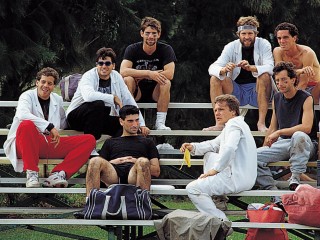The following piece is from Ultimate: The First Four Decades, available now in ebook form.
Windy City Ultimate was one of the most skilled, physical and controversial teams of the 1980s. The Chicago-based club was a true powerhouse, qualifying for 12 straight UPA Nationals beginning in 1982 and winning championships in 1983 and 1986.
“We came, we conquered and we could do whatever we wanted with the trophy, including spike it.” – Mike O’Dowd
Windy City was started in the late 1970s, when a talented group of Guts, disc golf, freestyle and all-around players from the Chicago’s North Side (Carey Goldenberg, Jose Montalvo, Chau Rottman, Mike O’Dowd and Mike Glass) joined a group of South Siders ( John, Dave, and Eddie O’Malley, Roy Carey and Joe Giampino). This Chicago core was complemented by some outstanding individual events players, John Connelly and Jordan Halpern; by graduates of a strong Southern Illinois University Full Tilt Ultimate–(John Conway, Dean Smith, Steve Whitehead, Scott Buchanan and Ted McGee); and by a few East Coast transplants (Chris Van Holmes, Paul Berg, Robert “Nob” Rauch, Robert and Eric Nesheim, Noam Frankel and Tom Coffin).
The team first qualified for Nationals in 1982 when it, along with the Tunas of St Louis, first supplanted Michigan State as the Central powerhouse. For nine straight years, Windy and the Tunas shared the Central region bids to Nationals, with Windy winning eight Central titles through 1993.
Windy City popularized several techniques now widespread throughout ultimate, including an aggressive offense, physical man-to-man play, the use of force middle, and occasional use of a unique 1-3-2-1 zone. With what amounted to a four-man cup, two short deeps and a deep-deep, this zone was often used to slow opponents’ big receivers.
“They won on risk-taking, talent and intensity,” said Boston’s Steve Mooney.
Offensively, Windy employed few set plays, instead cycling quickly up and down the field at full speed to tire other teams out.
“We used it to tire out opponents since we usually traveled with a large squad,” said Alan Goldenberg. “We had too many egos to structure anything more sophisticated. It was a good offense, but difficult to sustain for long stretches.”
Admirers called them “fearless,” detractors “brainless.”
“We certainly had some awesome throwing skills on the team and no fear of putting the disc in the air at any angle,” recalled Van Holmes. “Our receivers were great. Joe Giampino was a particular standout. He could catch anything.”
The majority of the Windy City players enjoyed other disc sports such as golf, Guts and Double Disc Court that improved their throwing skills. In 1984, the team won both Guts and ultimate at the World Ultimate and Guts Championships in Lucerne, Switzerland, becoming the only team ever to do so.
Windy dominated the 1986 championship tournament, beating the favored Titanic by five in the tourney opener and avenging their 1985 loss to KABOOM! in the semis. Chicago’s aggressive style dominated Flying Circus in the final, coasting to a 21-12 victory. Halpern punctuated the tournament by spiking the championship trophy.
“It wasn’t supposed to be a belittling of the trophy, or the sport,” O’Dowd said. “It was quite the contrary. We loved the game. We had just reached the top of the game. It was for us. We came, we conquered and we could do whatever we wanted with the trophy, including spike it.”
A year later, the zone helped Windy City clinch a finals berth with a semifinal victory over Titanic in the longest game ever played at Nationals in terms of total points, 25-24.
In the finals against the rising star, NYNY, winds swirling around the upwind stands stymied Windy’s risky choices, and NY’s patterned and talented offense was more than a match for Windy’s defense.
The following year, 1988, the semifinals again pitted Windy against Titanic. This time, Titanic used the zone to good advantage. Trailing 20-17, Titanic clamped a fluid zone around Windy’s throwers and took the victory at 23-21.
During the late 1980s and early ‘90s, O’Dowd, Glass and teammate Masa Honda organized annual friendship tours to Japan in which top teams and players visited Japan to teach, coach and demonstrate ultimate. This outreach was a big factor in the growth and development of ultimate in Japan.
Windy City reached the semis again in 1990 and 1992, but an aging, dispersing team was disbanded after reaching Nationals in San Antonio in 1993. Windy City’s last hurrah was a master’s championship in 1996.
Ultimate: The First Four Decades is available now for purchase on Google Books.








Comments Policy: At Skyd, we value all legitimate contributions to the discussion of ultimate. However, please ensure your input is respectful. Hateful, slanderous, or disrespectful comments will be deleted. For grammatical, factual, and typographic errors, instead of leaving a comment, please e-mail our editors directly at editors [at] skydmagazine.com.